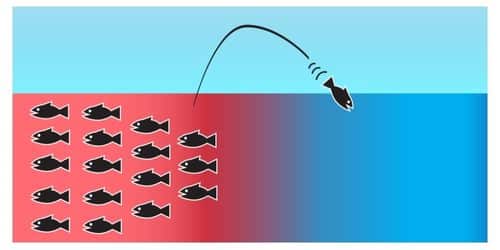Assume your products and services aren’t allowing you to fulfill your revenue targets. What if you could figure out how to alter your products and services so that they became their own industry? This is precisely what the “blue ocean” market implies, though household-name businesses did it long before a 2004 book named it. So read on to learn about blue ocean market intelligence, its market strategy, strategy examples, and company
Blue Ocean Market
From a marketing point of view, a “blue ocean” is an untapped or uncontested market space. In 2005, people in the entrepreneurship business came up with the term “blue ocean” to describe a new market with few competitors or roadblocks. When a new or unknown industry or innovation comes out, it creates a huge “empty ocean” of market options and chances.
INSEAD business school professors Chan Kim and Renee Mauborgne used the term “blue ocean” in their 2005 book Blue Ocean Strategy: How to Create Uncontested Market Space and Win Without Competitors. The authors describe “blue oceans” as markets with great profit potential.
In an industry that has been around for a while, companies compete for every bit of market share they can get. Often, there is so much competition that some businesses can’t stay in business. This sector of the economy is a “red ocean,” a market where competition has slashed prices. Blue oceans provide the opposite. Numerous businesses try to innovate or expand in the hopes of locating a blue ocean market devoid of competition. Entrepreneurs are also very interested in blue ocean markets.
Blue Ocean Market Intelligence
Blue ocean Market Intelligence is a global provider of analytics and insights that help companies get a 360-degree view of their customers by integrating data and taking a multi-disciplinary approach that lets them make good business decisions based on data. Given that we live in a very dynamic and multidimensional world, we believe that the most efficient business decisions are derived from a synthesis of data streams rather than from one-dimensional sources. With our 360 DiscoveryTM approach, we make sure to use all of the structured and unstructured data sources that are available. This lets us bring the best to each engagement. When analytics, domain knowledge, engineering, and visualization skills work together in harmony, they can help people make good decisions. Leading companies have more money, a 360-degree view of their markets and competitors, and better ways to get customers, keep them happy, and get more of them.
#1. Towards Becoming a Robust Data-Intensive Analytics Hub
The value of the blue ocean market proposition as a worldwide analytics and insights supplier includes marketing intelligence, big data analytics, and digital solutions. One of Blue ocean’s business services is the “Innovation Board.” This is where the company builds intellectual property (IP) in the form of proprietary frameworks and technology platforms built around data analysis tools.
Anees Merchant, senior vice president of Blue ocean Market Intelligence, says, “We are an analytics hub for global enterprises that want to know more about their customers so they can make decisions based on data.”
#2. Analytics for Better Customer Insights in Retail
Most stores make the most money during important seasonal and time-limited shopping times like Black Friday, Christmas, and back to school. During these important sales times, you need to make the most of these chances by increasing foot traffic, site traffic, conversions, and purchases. To do this, retailers need complete, up-to-date, and actionable intelligence. With the right analytics solution, Blueocean knew it could meet this need.
“You need powerful data analytics tools to combine multiple data streams to get this kind of customer insight.” “It’s really important that we pick the right analytical tool that can give us a full picture of the data and give our customers powerful insights,” he says.
In order to do this, Blue Ocean needed analytical software to build its marketing technology analytics solution on. At the same time, the company wanted a tool that its team of experts in data visualization and analysis could easily understand and use to get insights for customers.
#3. Practicing the Science of Data Analytics
Blueocean had been using Tableau 7 in some of its IP solutions, and it had chosen Corporate Renaissance Group (CRG) as a partner to help it deploy the tool. moreover, During the deployment stage, CRG was able to share best practices from the industry and work with Blue Ocean on pilots. This gave Blue Ocean a better idea of how to use Tableau to its fullest potential. However, Blue Ocean then upgraded to a newer version, Tableau 8.1. As the company continued to work with Tableau, it began to realize that this would be the best choice for its new event-based retail intelligence solution, Retail Intelligence on Demand. So, it decided to take advantage of Tableau 8.1’s many features to give clients more value.
Customers were very interested in the solution because it gave them accurate and up-to-date data that helped them understand how competitors were acting and how customers were behaving, so they could respond.
#4. Ensuring a 360 Degrees Approach to Visualization and Analytics
Blue ocean market intelligence uses Tableau to synthesize data from SAP databases, Adobe digital analytics, Facebook, Twitter, YouTube, and other social media channels, CRM and ERP systems, and other behavioral data sources in a cloud-based environment.
The company publishes data visualizations from Tableau Desktop to Tableau Server so that people can share insights and work together. As the amount of data grows, Blue Ocean uses Tableau to look at more than a million data points every month. Also, this helps Blueocean Market Intelligence democratize data within and among its clients.
“Real intelligence comes from a well-rounded, triangulated view of data in silos across our customer’s company.” furthermore, “Tableau’s ability to fit into different situations and give the most useful information in a simple but powerful way helps us give better value to clients,” says Anees Merchant, Blue Ocean Market Intelligence.
Blue Ocean Market Strategy
A “blue ocean strategy” refers to a market for a product that has no or very little competition. This method is looking for a business in which there are few competitors and no pricing pressure. Any business or industry can use the Blue Ocean Strategy. It is not just for one business. Let’s talk about the Blue Ocean strategy.
Tips On Applying the Blue Ocean Strategy
The famous Eliminate-Reduce-Raise-Create (ERRC) framework is at the heart of the Blue Ocean Strategy’s nuclear execution principle.
The ERRC framework helps companies stay focused on two parts of a new blue ocean: getting rid of and lowering costs, raising prices, and making new things.
Read on for some tips and tricks for making a strong blue ocean market strategy.
#1. Analyze Industries
First, you should look at the market in depth to find a new trend or demand. Look at the product and how it makes customers feel. Check to see if customers are happy with the services you already offer.
#2. Define a Problem
Instead of fighting for the options that are already there, you should try to solve other customer problems. When you find something that isn’t as good as it could be, think about how your offer can make this customer feel better. Therefore, think about how you can make your customers’ lives easier, not what your competitors have done wrong.
#3. Follow the ERRC Framework
The main task is to create a plan that includes four key concepts. The answers to these questions will serve as the foundation for the action plan.
- Eliminate-Which factors that have long been fulfilled by the industry should be eliminated?
- Raise-Which features should be elevated significantly above industry standards?
- Reduce-Which elements should be reduced significantly below the industry standard?
- Create– What factors should be developed that the industry has never provided?
#4. Implement
Once you have a summary of your blue ocean market strategy, it’s time to put it to use. Kim and Mauborgne say to do these things:
- Set a date to start selling your new products, and hire people to build your team and brand.
- Find out what your team’s strengths and weaknesses are and work to improve them.
- Find out what may be bothering your current and potential new clients.
- Make products and services that solve these problems in ways that no other company has ever thought of.
- Write down a formal plan for the change and test your new products and services, as well as the steps you’ll need to take to get there.
- When you’ve gone over the above plan, you’re ready to go into a new market. Still, a blue ocean strategy isn’t the holy grail, but it will work if you know how to use it.
Blue Ocean Company
The term “blue ocean company” exists in the business world to describe a new market where there isn’t much competition or other things that may stand in the way of entrepreneurs. When a new or undiscovered company or innovation develops, it creates a wide “empty ocean” of market possibilities and potential.
Examples of Blue Ocean Company
A blue ocean is unique to a certain place and time. Ford and Apple are two examples of big companies that created their own “blue oceans” by trying to make their products stand out while keeping costs low. This made it harder for other companies to compete with them. They were also great examples of industries that were growing at the time and that others followed.
#1. Ford Motor Company
In 1908, Ford Motor Co. made the Model T, which was meant to be a car for everyone. It only came in one color and one model, but it worked well, lasted a long time, and wasn’t too expensive. At the time, the auto industry was just getting started. There were only about 500 automakers making expensive, less reliable cars that were made to order. Ford came up with a new way to make standard cars in large numbers at a fraction of the cost of its competitors.
The Model T’s market share went from 9% in 1908 to 61% in 1921, making it the main way to get around instead of the horse-drawn carriage.
#2. Apple, Inc.
With its iTunes music download service, Apple Inc. found a “blue ocean company.” Hence, In 2003, Apple created the first legal way to download music. Before that, billions of music files were being downloaded illegally every month.
It was easy to use, and people could buy songs individually at a reasonable price. Millions of people who used to download music illegally switched to Apple because it had better sound and search and navigation tools. Indeed, Apple made iTunes a win-win-win situation for the people who make music, the people who listen to music, and Apple itself by opening up a new market and making it easier for people to get music.
#3. Netflix
A company like Netflix, which changed the entertainment business in the 2000s, is another example of a blue ocean company. Netflix didn’t want to join the already-crowded market of video rental stores, so it came up with new ways to have fun. First, it introduced mail-order video rentals, and later, it was the first company to offer a streaming video service that was paid for by user subscriptions. After their success, many other companies have tried to do what Netflix did. So, any new company that wants to start a video subscription model will face a “red ocean” instead of a “blue ocean.”
Blue Ocean Strategy Examples
Even though every company differs, there is always something that makes them all successful. We talked about how these well-known brands used the blue ocean strategy in their businesses to show the pros and cons of the approach.
#1. Cirque du Soleil
Cirque du Soleil is without a doubt one of the best-known examples of the blue ocean strategy. they changed the circus business by focusing on low costs and being different. Since the early 1980s, the company has made 155 million people happy in more than 300 places. Cirque du Soleil created things that had never been seen before in the circus world by focusing on human physical skill, live music, and plots that were inspired by theater.
#2. Marvel
In 1939, Marvel started out as a normal company that made comic books for kids. Then, when it started to focus on college students, Marvel started making characters with more depth. The most important thing was being a person. Marvel created a new value and used the advantages of the blue ocean strategy to the fullest. By creating the multiverse, Marvel jumped into a clear ocean, as different characters from different movies were linked and brought together. So, Marvel became the biggest comic book company in the US.
#3. HealthMedia
HealthMedia, a player in the market that made $6 million, was going out of business because there was so much competition. Later, HealthMedia found out that customers switched to phone counseling because it was very effective. To do this, HealthMedia set up interactive online questionnaires that matched people’s health plans with the problems they were having. They came up with the idea of “digital health coaching.”
What Does Blue Ocean Mean in Marketing?
Professors W. Chan Kim and Rénee Mauborgne came up with the term “blue ocean strategy” in 2005. It means going into a market space where there is little or no competition instead of trying to compete for customers in a market that is getting more and more crowded.
What Does Blue Oceans Mean in Business?
The blue ocean strategy is about making products that are both unique and cheap, which makes the competition irrelevant. The term “blue ocean strategy” comes from the book Blue Ocean Strategy: How to Create Uncontested Market Space and Make Competition Irrelevant.
What Is an Example of a Blue Ocean Company?
Cirque du Soleil is a classic example of a blue ocean strategy.
This Canadian entertainment company is one of the most well-known examples of the blue ocean strategy. The company created a market space that no one else wanted, making the competition irrelevant.
What Is the Difference Between Red Ocean and Blue Ocean Markets?
“Blue ocean” is a business strategy that focuses on making new markets instead of competing in the ones that already exist. A “red ocean” is a market that already exists and has many competitors. A “blue ocean” is a market that hasn’t been found yet and has no competitors.
What Are the 4 Strategies of Blue Ocean Strategy?
THE PROCESS OF CREATING A BLUE OCEAN. Blue ocean strategies must be developed in the order of buyer utility, price, cost, and adoption. This enables them to construct a viable business model and ensure that a company profits from the blue ocean they are creating.
What Are the 6 Principles of Blue Ocean Strategy?
- Look across alternative industries.
- Look across strategic groupings within an industry
- Look across buyer groups
- Look across complementary product and service offerings
- Look across an industry’s functional-emotional orientation.






